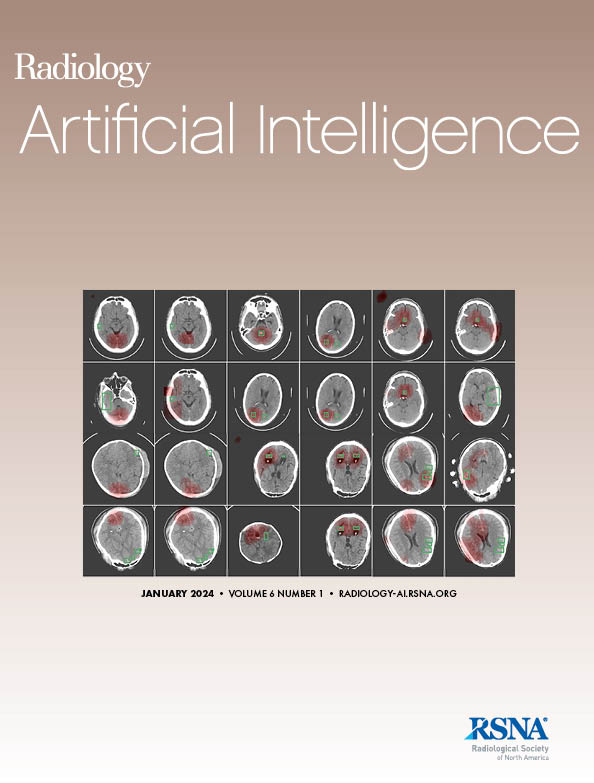Yao-Kuan Wang, Zan Klanecek, Tobias Wagner, Lesley Cockmartin, Nicholas Marshall, Andrej Studen, Robert Jeraj, Hilde Bosmans
求助PDF
{"title":"使用可解释的AI来描述Mirai乳房x线摄影乳腺癌风险预测模型中的特征。","authors":"Yao-Kuan Wang, Zan Klanecek, Tobias Wagner, Lesley Cockmartin, Nicholas Marshall, Andrej Studen, Robert Jeraj, Hilde Bosmans","doi":"10.1148/ryai.240417","DOIUrl":null,"url":null,"abstract":"<p><p>Purpose To evaluate whether features extracted by Mirai can be aligned with mammographic observations, and contribute meaningfully to the prediction. Materials and Methods This retrospective study examined the correlation of 512 Mirai features with mammographic observations in terms of receptive field and anatomic location. A total of 29,374 screening examinations with mammograms (10,415 women, mean age at examination 60 [SD: 11] years) from the EMBED Dataset (2013-2020) were used to evaluate feature importance using a feature-centric explainable AI pipeline. Risk prediction was evaluated using only calcification features (CalcMirai) or mass features (MassMirai) against Mirai. Performance was assessed in screening and screen-negative (time-to-cancer > 6 months) populations using the area under the receiver operating characteristic curve (AUC). Results Eighteen calcification features and 18 mass features were selected for CalcMirai and MassMirai, respectively. Both CalcMirai and MassMirai had lower performance than Mirai in lesion detection (screening population, 1-year AUC: Mirai, 0.81 [95% CI: 0.78, 0.84], CalcMirai, 0.76 [95% CI: 0.73, 0.80]; MassMirai, 0.74 [95% CI: 0.71, 0.78]; <i>P</i> values < 0.001). In risk prediction, there was no evidence of a difference in performance between CalcMirai and Mirai (screen-negative population, 5-year AUC: Mirai, 0.66 [95% CI: 0.63, 0.69], CalcMirai, 0.66 [95% CI: 0.64, 0.69]; <i>P</i> value: 0.71); however, MassMirai achieved lower performance than Mirai (AUC, 0.57 [95% CI: 0.54, 0.60]; <i>P</i> value < .001). Radiologist review of calcification features confirmed Mirai's use of benign calcification in risk prediction. Conclusion The explainable AI pipeline demonstrated that Mirai implicitly learned to identify mammographic lesion features, particularly calcifications, for lesion detection and risk prediction. ©RSNA, 2025.</p>","PeriodicalId":29787,"journal":{"name":"Radiology-Artificial Intelligence","volume":" ","pages":"e240417"},"PeriodicalIF":13.2000,"publicationDate":"2025-09-03","publicationTypes":"Journal Article","fieldsOfStudy":null,"isOpenAccess":false,"openAccessPdf":"","citationCount":"0","resultStr":"{\"title\":\"Using Explainable AI to Characterize Features in the Mirai Mammographic Breast Cancer Risk Prediction Model.\",\"authors\":\"Yao-Kuan Wang, Zan Klanecek, Tobias Wagner, Lesley Cockmartin, Nicholas Marshall, Andrej Studen, Robert Jeraj, Hilde Bosmans\",\"doi\":\"10.1148/ryai.240417\",\"DOIUrl\":null,\"url\":null,\"abstract\":\"<p><p>Purpose To evaluate whether features extracted by Mirai can be aligned with mammographic observations, and contribute meaningfully to the prediction. Materials and Methods This retrospective study examined the correlation of 512 Mirai features with mammographic observations in terms of receptive field and anatomic location. A total of 29,374 screening examinations with mammograms (10,415 women, mean age at examination 60 [SD: 11] years) from the EMBED Dataset (2013-2020) were used to evaluate feature importance using a feature-centric explainable AI pipeline. Risk prediction was evaluated using only calcification features (CalcMirai) or mass features (MassMirai) against Mirai. Performance was assessed in screening and screen-negative (time-to-cancer > 6 months) populations using the area under the receiver operating characteristic curve (AUC). Results Eighteen calcification features and 18 mass features were selected for CalcMirai and MassMirai, respectively. Both CalcMirai and MassMirai had lower performance than Mirai in lesion detection (screening population, 1-year AUC: Mirai, 0.81 [95% CI: 0.78, 0.84], CalcMirai, 0.76 [95% CI: 0.73, 0.80]; MassMirai, 0.74 [95% CI: 0.71, 0.78]; <i>P</i> values < 0.001). In risk prediction, there was no evidence of a difference in performance between CalcMirai and Mirai (screen-negative population, 5-year AUC: Mirai, 0.66 [95% CI: 0.63, 0.69], CalcMirai, 0.66 [95% CI: 0.64, 0.69]; <i>P</i> value: 0.71); however, MassMirai achieved lower performance than Mirai (AUC, 0.57 [95% CI: 0.54, 0.60]; <i>P</i> value < .001). Radiologist review of calcification features confirmed Mirai's use of benign calcification in risk prediction. Conclusion The explainable AI pipeline demonstrated that Mirai implicitly learned to identify mammographic lesion features, particularly calcifications, for lesion detection and risk prediction. ©RSNA, 2025.</p>\",\"PeriodicalId\":29787,\"journal\":{\"name\":\"Radiology-Artificial Intelligence\",\"volume\":\" \",\"pages\":\"e240417\"},\"PeriodicalIF\":13.2000,\"publicationDate\":\"2025-09-03\",\"publicationTypes\":\"Journal Article\",\"fieldsOfStudy\":null,\"isOpenAccess\":false,\"openAccessPdf\":\"\",\"citationCount\":\"0\",\"resultStr\":null,\"platform\":\"Semanticscholar\",\"paperid\":null,\"PeriodicalName\":\"Radiology-Artificial Intelligence\",\"FirstCategoryId\":\"1085\",\"ListUrlMain\":\"https://doi.org/10.1148/ryai.240417\",\"RegionNum\":0,\"RegionCategory\":null,\"ArticlePicture\":[],\"TitleCN\":null,\"AbstractTextCN\":null,\"PMCID\":null,\"EPubDate\":\"\",\"PubModel\":\"\",\"JCR\":\"Q1\",\"JCRName\":\"COMPUTER SCIENCE, ARTIFICIAL INTELLIGENCE\",\"Score\":null,\"Total\":0}","platform":"Semanticscholar","paperid":null,"PeriodicalName":"Radiology-Artificial Intelligence","FirstCategoryId":"1085","ListUrlMain":"https://doi.org/10.1148/ryai.240417","RegionNum":0,"RegionCategory":null,"ArticlePicture":[],"TitleCN":null,"AbstractTextCN":null,"PMCID":null,"EPubDate":"","PubModel":"","JCR":"Q1","JCRName":"COMPUTER SCIENCE, ARTIFICIAL INTELLIGENCE","Score":null,"Total":0}
引用次数: 0
引用
批量引用

 求助内容:
求助内容: 应助结果提醒方式:
应助结果提醒方式:


